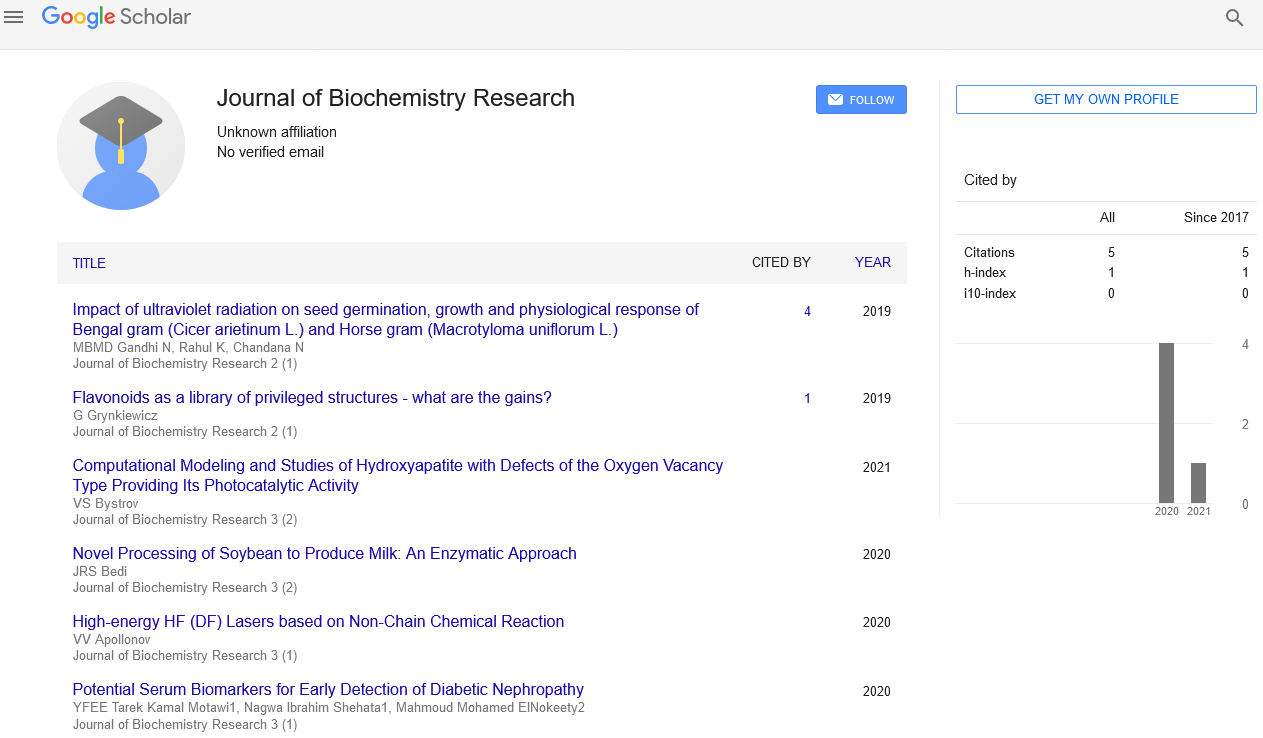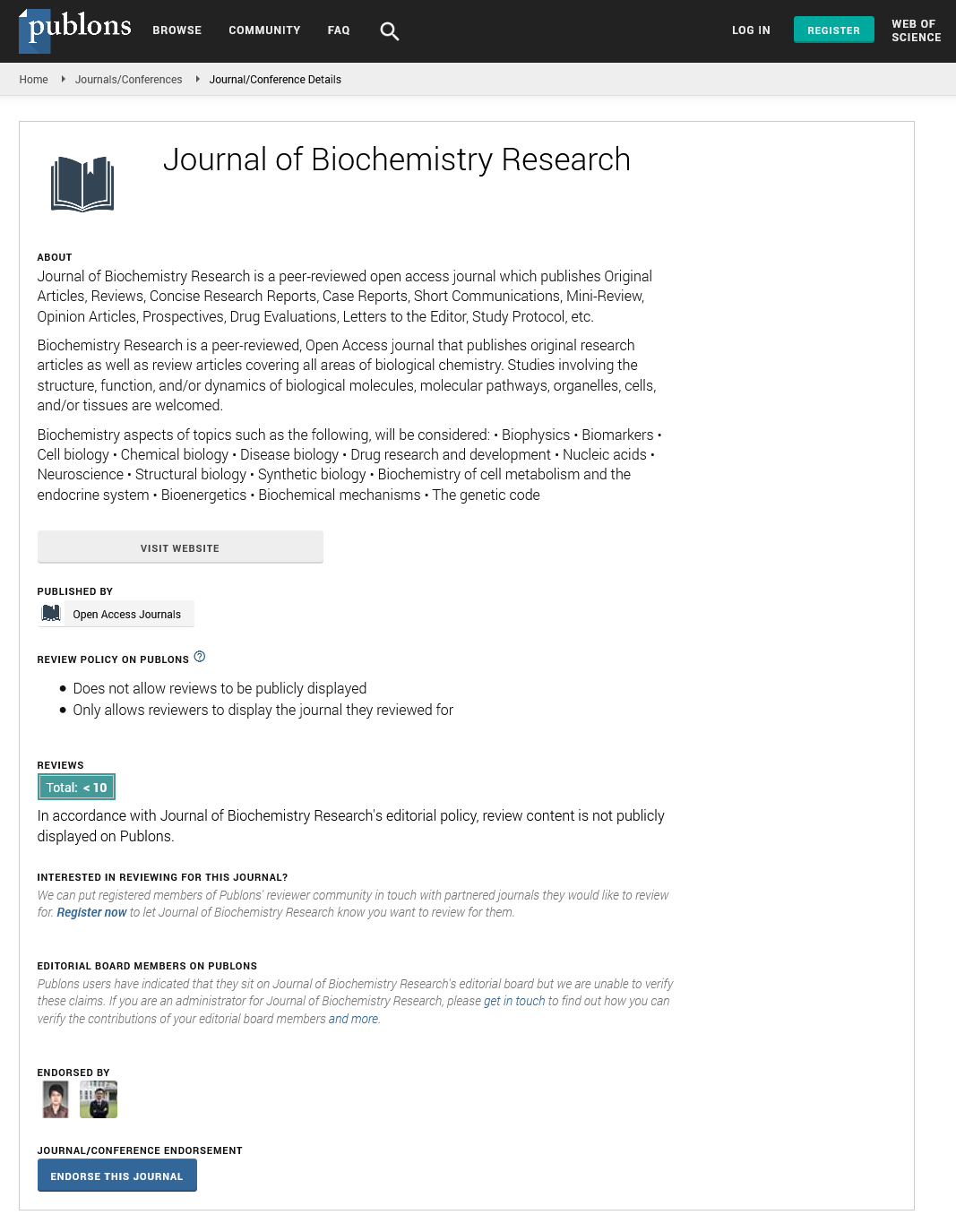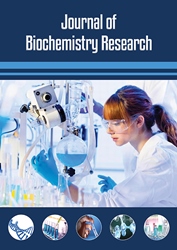Editorial - Journal of Biochemistry Research (2023) Volume 6, Issue 4
Unraveling the Machinery of Protein Synthesis: Insights into the Cellular Processes that Build the Building Blocks of Life
Sakina Khan*
Department of Clinical Biochemistry, University of Gujrat, India
Department of Clinical Biochemistry, University of Gujrat, India
E-mail: SakinaKhan43@gmail.com
Received: 1-August-2023, Manuscript No.oabr-23-109725; Editor assigned: 4- August-2023, Pre-QC No.oabr-23-109725 (PQ); Reviewed: 14-August-2023, QC No.oabr-23-109725; Revised: 22-August-2023, Manuscript No.oabr-23-109725 (R); Published: 31-August-2023 DOI: 10.37532/ oabr.2023.6(4).117-119
Abstract
Protein synthesis is a fundamental cellular process that lies at the heart of life’s complexity. It is a highly orchestrated and intricate mechanism by which the genetic information encoded in DNA is translated into functional proteins, the building blocks of life. This article delves into the captivating world of protein synthesis, seeking to unravel the molecular machinery and cellular processes that underlie this essential biological phenomenon. Drawing from the fields of molecular biology, biochemistry, and genetics, this exploration investigates the step-by-step process of protein synthesis. It begins with the transcription of DNA into messenger RNA (mRNA) in the nucleus, followed by the export of mRNA to the cytoplasm, where translation occurs. The ribosome, a molecular complex composed of ribosomal RNA (rRNA) and proteins, plays a central role in translating the genetic code into the primary structure of proteins. The discussion encompasses the roles of transfer RNA (tRNA) molecules, which carry specific amino acids to the ribosome, and the decoding of the mRNA codons by the ribosome to determine the sequence of amino acids in the growing polypeptide chain. Post-translational modifications and protein folding further refine the newly synthesized proteins to achieve their functional three-dimensional structures. Furthermore, this article explores the regulatory mechanisms that govern protein synthesis, including transcriptional and translational controls. These mechanisms enable cells to adjust their protein synthesis rates in response to internal and external stimuli, ensuring proper cellular function and adaptation to changing conditions. The significance of understanding protein synthesis extends beyond basic science. Dysregulation of this process underlies various diseases, and insights into the molecular basis of protein synthesis provide potential targets for therapeutic intervention and drug development. In conclusion, the exploration of protein synthesis sheds light on the intricate machinery and cellular processes that build the foundation of life. Unraveling the molecular intricacies of protein synthesis deepens our understanding of cellular function and adaptation, while also holding promise for advancing biotechnology, medicine, and our quest to decipher the secrets of life itself. As we continue to delve into the machinery of protein synthesis, we gain valuable insights that will shape the future of scientific discovery and improve our understanding of life’s complexity and diversity.
Keywords
Protein synthesis • Cellular processes • Genetic information • DNA transcription
Introduction
Protein synthesis, a remarkable cellular process, lies at the very heart of life’s complexity. It is the intricate and highly regulated machinery that translates the genetic information encoded in DNA into functional proteins, the fundamental building blocks of life [1]. The elegant dance of cellular processes involved in this synthesis has fascinated scientists for decades, as it governs the creation and maintenance of the myriad proteins that drive cellular function and orchestrate the dynamic processes of living organisms [2]. In this exploration, we embark on a captivating journey into the world of protein synthesis, seeking to unravel the molecular machinery and cellular processes that underlie this essential biological phenomenon [3]. Drawing upon the intersections of molecular biology, biochemistry, and genetics, we delve into the step-by-step mechanism of protein synthesis, from the transcription of DNA into messenger RNA (mRNA) within the nucleus to the translation of the genetic code into polypeptide chains within the cytoplasm [4]. At the heart of this process lies the ribosome, a sophisticated molecular complex composed of ribosomal RNA (rRNA) and proteins. [5] The ribosome acts as a translational “machine” that reads the mRNA codons and assembles the corresponding amino acids into growing polypeptide chains, precisely following the genetic blueprint [6]. The cellular ballet of protein synthesis also involves transfer RNA (tRNA) molecules, each carrying specific amino acids to the ribosome, and the decoding of mRNA codons to determine the sequence of amino acids in the synthesized protein. Posttranslational modifications and intricate protein folding further refine the newly synthesized proteins, ultimately ensuring they acquire their functional three-dimensional structures [7]. Furthermore, the exploration extends to the regulatory mechanisms that govern protein synthesis [8]. Cells employ transcriptional and translational controls to adjust the rate and production of specific proteins in response to internal and external stimuli [9]. This exquisite regulation ensures proper cellular function and adaptation to varying environmental conditions. The significance of understanding protein synthesis reaches beyond the boundaries of basic science [10]. Dysregulation of this process is implicated in various diseases, and insights into the molecular basis of protein synthesis offer potential targets for therapeutic intervention and drug development. As we begin this journey into the machinery of protein synthesis, we are filled with a sense of awe and curiosity for the complexity and elegance of these cellular processes. Unraveling the intricacies of protein synthesis not only deepens our understanding of cellular function but also holds promise for advancing biotechnology, medicine, and our quest to decipher the mysteries of life itself. As we delve further into the mysteries of protein synthesis, we anticipate that each revelation will bring us closer to comprehending the secrets of life’s intricate dance and the transformative potential it holds for scientific discovery and human well-being.
Discussion
The Transcription-Translation Machinery: Participants can delve into the intricate process of protein synthesis, starting with DNA transcription in the nucleus and the export of mRNA to the cytoplasm, where translation occurs. The role of ribosomes, rRNA, and proteins in the translation process can be explored, along with the significance of tRNA in bringing specific amino acids to the ribosome. Genetic Code and Amino Acid Sequences: The discussion can focus on the decoding of the mRNA codons by the ribosome to determine the sequence of amino acids in the synthesized protein. Participants can explore how the genetic code is universal, enabling the same genetic language to be used by all living organisms. Post- Translational Modifications and Protein Folding: The exploration can extend to post-translational modifications, where proteins undergo chemical changes after translation, influencing their function and localization. The importance of proper protein folding in achieving functional three-dimensional structures can also be discussed. Regulation of Protein Synthesis: Participants can discuss the regulatory mechanisms that control protein synthesis, including transcriptional and translational controls. The significance of these controls in adjusting the rate and production of specific proteins in response to cellular needs and environmental cues can be explored. Cellular Adaptation and Function: The discussion can highlight how the machinery of protein synthesis plays a pivotal role in cellular adaptation and function. Participants can explore how cells modulate protein synthesis to respond to stress, developmental changes, and other physiological demands. Dysregulation and Disease: The implications of dysregulation of protein synthesis in various diseases can be discussed. Participants can explore how disruptions in the translation process contribute to neurodegenerative disorders, cancer, and other pathological conditions. Therapeutic Intervention and Drug Development: The exploration can extend to potential therapeutic approaches targeting the machinery of protein synthesis. Participants can discuss how understanding the molecular basis of protein synthesis offers opportunities for drug development and personalized medicine strategies. Biotechnological Applications: The practical applications of unraveling the machinery of protein synthesis in biotechnology can be explored. Participants can discuss how this knowledge is harnessed for the production of recombinant proteins, gene editing, and synthetic biology. Future Directions: Participants can address current challenges in studying protein synthesis, such as the need for advanced imaging techniques and computational modeling. The discussion can also explore future research directions and the potential for interdisciplinary collaborations to advance our understanding of cellular processes.
Conclusion
Understanding the molecular basis of protein synthesis has unveiled the significance of ribosomes, tRNA, and mRNA in translating the genetic code into functional proteins. The decoding of codons and the precise assembly of amino acids into polypeptide chains emphasize the universality and precision of the genetic language shared by all living organisms. Moreover, the process of post-translational modifications and protein folding has illuminated how cells refine the newly synthesized proteins to acquire their functional three-dimensional structures. This ensures that proteins are equipped to perform their diverse roles in cellular physiology, metabolism, and regulation. Beyond its fundamental role in cellular function, the machinery of protein synthesis plays a pivotal role in cellular adaptation and response to changing environmental conditions. The regulatory controls governing protein synthesis enable cells to adjust their protein production rates, ensuring that they meet the demands of physiological requirements. The implications of understanding protein synthesis extend far beyond the confines of scientific knowledge. Dysregulation of this intricate process underlies a myriad of diseases, highlighting the importance of investigating the molecular basis of protein synthesis for potential therapeutic interventions and drug development. As we conclude this exploration, we are reminded of the transformative potential that lies in unraveling the machinery of protein synthesis. From biotechnological applications to personalized medicine strategies, this knowledge empowers us to harness the wonders of cellular processes for the betterment of humanity and the world we inhabit. The journey of understanding the machinery of protein synthesis is an ongoing quest, with each revelation opening new frontiers in scientific discovery. As we continue to delve deeper into the intricacies of cellular biology, we gain valuable insights that enrich our appreciation for the elegance and complexity of life. Armed with this knowledge, we are poised to shape the future of scientific research, biotechnological advancements, and medical breakthroughs, thereby unlocking the mysteries of life’s molecular intricacies and contributing to the betterment of human health and well-being.
References
- Ogurtsova K, Fernandes JD, Huang Y et al. IDF Diabetes Atlas Global estimates for the prevalence of diabetes. Diabetes Res Clin Pract. 128, 40-50 (2017).
- Zhou Z, Mahdi A, Tratsiakovich Y et al. Erythrocytes From Patients With Type 2 Diabetes Induce Endothelial Dysfunction Via Arginase I. J Am Coll Cardiol. 72, 769-780 (2018).
- Sprague RS, Stephenson AH, EA Bowles et al. Reduced expression of Gi in erythrocytes of humans with type 2 diabetes is associated with impairment of both cAMP generation and ATP release. Diabetes. 55, 3588-3593.
- Blaslov K, Kruljac I, Mirošević G et al. The prognostic value of red blood cell characteristics on diabetic retinopathy development and progression in type 2 diabetes mellitus. Clin Hemorheol Microcirc. 71, 475-481 (2019).
- Venerando B, Fiorilli A, Croci G et al. Acidic and neutral sialidase in the erythrocyte membrane of type 2 diabetic patients. Blood. 99, 1064-1070 (2002).
- Kadiyala R, Peter R, Okosieme OE et al. Thyroid dysfunction in patients with diabetes: clinical implications and screening strategies. Int J Clin Pract. 64, 1130-1139 (2010).
- Clark A, Jones LC, de Koning E et al. Decreased insulin secretion in type 2 diabetes: a problem of cellular mass or function. Diabetes. 50, 169-171 (2001).
- DeFronzo RA. Pathogenesis of type 2 diabetes: metabolic and molecular implications for identifying diabetes genes. Diabetes Reviews. 5, 177-269 (1997).
- Peppa M, Betsi G, Dimitriadis G et al. Lipid abnormalities and cardio metabolic risk in patients with overt and subclinical thyroid disease. J Lipids. 9, 575-580 (2011).
- Cettour-Rose P, Theander-Carrillo C, Asensio C et al. Hypothyroidism in rats decreases peripheral glucose utilisation, a defect partially corrected by central leptin infusion. Diabetologia. 48, 624-633 (2005).
Google Scholar, Crossref, Indexed at
Google Scholar, Crossref, Indexed at
Google Scholar, Crossref, Indexed at
Google Scholar, Crossref, Indexed at
Google Scholar, Crossref, Indexed at
Google Scholar, Crossref, Indexed at
Google Scholar, Crossref, Indexed at
Google Scholar, Crossref, Indexed at
Google Scholar, Crossref, Indexed at


